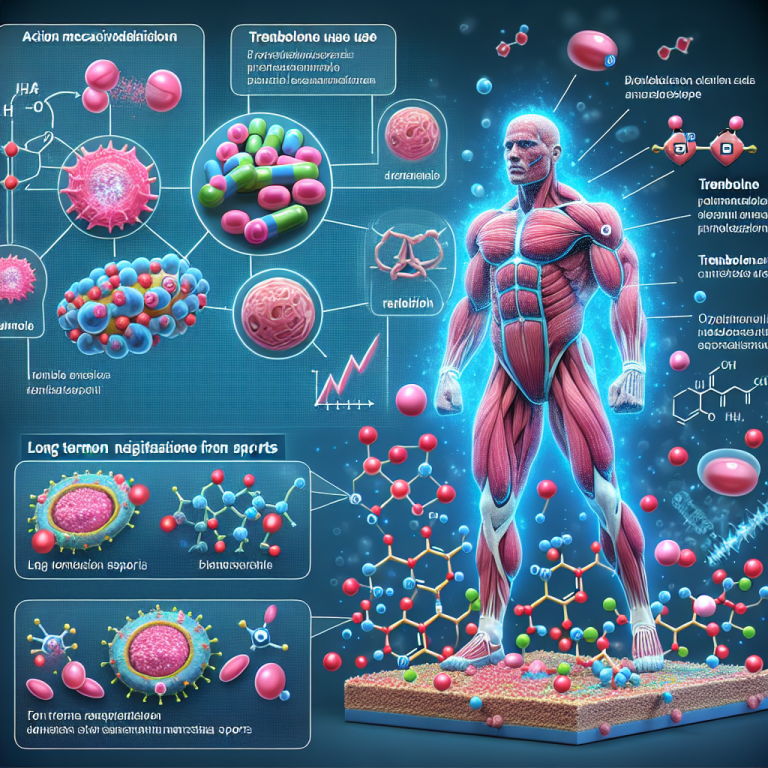-
Table of Contents
Trenbolone: Action Mechanism and Potential Risks in Sports
Trenbolone, also known as Tren, is a synthetic anabolic-androgenic steroid (AAS) that has gained popularity among athletes and bodybuilders for its ability to increase muscle mass and strength. However, with its powerful effects also come potential risks and side effects that must be carefully considered before use. In this article, we will explore the action mechanism of Trenbolone and its potential risks in sports.
What is Trenbolone?
Trenbolone is a modified form of the hormone Nandrolone, with an added double bond at the 9th and 11th carbon positions. This modification increases its binding affinity to the androgen receptor, making it more potent than testosterone. Trenbolone is available in three forms: Trenbolone Acetate, Trenbolone Enanthate, and Trenbolone Hexahydrobenzylcarbonate (Parabolan).
Originally developed for veterinary use to promote muscle growth in cattle, Trenbolone has become a popular choice among athletes and bodybuilders due to its anabolic effects. It is often used in bulking cycles to increase muscle mass and strength, as well as in cutting cycles to preserve muscle while reducing body fat.
Action Mechanism of Trenbolone
Trenbolone works by binding to the androgen receptor, which then activates the androgen receptor signaling pathway. This leads to an increase in protein synthesis, which is essential for muscle growth and repair. Trenbolone also has a high affinity for the glucocorticoid receptor, which helps to reduce the catabolic effects of cortisol on muscle tissue.
In addition to its anabolic effects, Trenbolone also has a strong androgenic effect, which contributes to its ability to increase strength and aggression. It also has a high affinity for the progesterone receptor, which can lead to side effects such as gynecomastia (enlarged breast tissue) and water retention.
Potential Risks of Trenbolone in Sports
While Trenbolone may offer significant benefits in terms of muscle growth and strength, it also comes with potential risks and side effects that must be carefully considered before use. These risks include:
- Cardiovascular Effects: Trenbolone can increase blood pressure and cholesterol levels, which can increase the risk of cardiovascular disease. It can also cause left ventricular hypertrophy, a condition where the heart muscle thickens, which can lead to heart failure.
- Hepatotoxicity: Trenbolone is metabolized by the liver, and prolonged use can cause liver damage. This can lead to liver dysfunction and even liver cancer.
- Endocrine Disruption: Trenbolone can suppress the body’s natural production of testosterone, leading to hormonal imbalances. This can result in side effects such as testicular atrophy, decreased libido, and erectile dysfunction.
- Psychological Effects: Trenbolone can also have psychological effects, such as increased aggression, mood swings, and even depression. These effects can be exacerbated in individuals with a history of mental health issues.
It is also important to note that Trenbolone is a banned substance in most sports organizations and is classified as a Schedule III controlled substance in the United States. Its use without a prescription is illegal and can result in serious legal consequences.
Expert Opinion
According to a study by Hartgens and Kuipers (2004), the use of Trenbolone in sports is associated with a significant increase in muscle mass and strength. However, they also note that the potential risks and side effects of Trenbolone must be carefully considered, and its use should be closely monitored by a healthcare professional.
In addition, a study by Kicman (2008) found that Trenbolone use can lead to adverse effects on the cardiovascular system, liver, and endocrine system. They also note that the long-term effects of Trenbolone use are still unknown and require further research.
Conclusion
Trenbolone is a powerful AAS that offers significant benefits in terms of muscle growth and strength. However, its use also comes with potential risks and side effects that must be carefully considered. It is important for athletes and bodybuilders to weigh the potential benefits against the potential risks and to use Trenbolone under the supervision of a healthcare professional.
References
Hartgens, F., & Kuipers, H. (2004). Effects of androgenic-anabolic steroids in athletes. Sports Medicine, 34(8), 513-554.
Kicman, A. T. (2008). Pharmacology of anabolic steroids. British Journal of Pharmacology, 154(3), 502-521.
